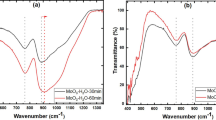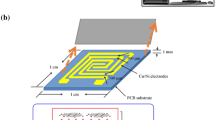Abstract
The poor conductivity of oxides such as TiO2 is the big challenge that severely restricts their applications in the gas sesnor field. The rational design of their electronic structure and nano/micro structure is an effective approach to solve this problem. The spin coating approach was used to create a combined strategy of MOF-derived TiO2 thin films in this work. Various characterization methods, such as XRD, Raman, TEM, and XPS analyses, were used to examine the produced sensor films. XRD and Tem results suggest that MOF could significantly improve the structural and morphological properties of TiO2. SEM and TEM clearly shows that TiO2 have nanoparticles and nanosheets morphologies and the spherical shaped individual nanoparticles sizes in the range of 25–35 nm was found in the TiO2 sample. Chemiresistive gas sensors made from this MOF-TiO2 had much better NO2-sensing capability than pristine TiO2, as well as higher sensitivity (response of 84.6% under 1000 ppm) and faster response and recovery times (45 s/57 s). The unique porous structure with high specific surface area and plentiful accessible active sites with surface-adsorbed oxygen is attributed to the MOF-derived TiO2 improved sensing capability.








Similar content being viewed by others
Data availability
The data that support the findings of this study are available from the corresponding author, upon reasonable request.
References
P. Maria, M. Bruno, Thick-film sensors: an overview. Sens. Actuators 10, 65–82 (1986)
S.K. Joshi, C.N.R. Rao, T. Tsuruto, S. Nagakura, Gas sensor Materials in ‘New Material’ (Narosa Publishing house, New Delhi, 1992), pp.1–37
M. Kulwicki Bernard, Humidity sensors. J. Am. Ceram. Soc. 74, 697–708 (1991)
N. Yamazoe, Y. Shimizu, Humidity sensors: principles and applications. Sens Actuators 10, 379–398 (1986)
M.J. Madou, S.R. Morrison, Chemical sensing with solid-state devices (Academic press Inc, San Diego, 1989)
A.M. Azad, S.A. Akbar, S.G. Mhaisalkar, L.D. Birkefeld, K.S. Goto, Solid-state gas sensors:a review. J. Electrochem. Soc. 139, 3690–3704 (1992)
P.T. Moseley, Materials and Mechanism in semiconductor gas sensors: Technology, system and application (Gas sensor) (IOP Publishing, Bristol, 1990), pp.89–99
K. Tian, **ao-Xue Wang, Hua-Yao Li, Reddeppa Nadimicherla, **n Guo, Lotus pollen derived 3-dimensional hierarchically porous NiO microspheres for NO2 gas sensing. Sens. Actuators B-Chem. 227, 554–560 (2016)
A. Sharma, M. Tomar, V. Gupta, Room temperature trace level detection of NO2 gas using SnO2 modified carbon nanotubes based sensor. J. Mater. Chem. 22, 23608–23616 (2012)
A. Afzal, N. Cioffi, Luigi Sabbatini, Luisa Torsi, NOx sensors based on semiconducting metal oxide nanostructures: progress and perspectives. Sens. Actuators. B-Chem. 171–172, 25–42 (2012)
M. Mosharrafhossainbhuiyan, T. Ueda, T. Ikegami, K. Ebihara, Gas sensing properties of metal doped WO3 thin film sensors prepared by pulsed laser deposition and DC sputtering process. Japanese J. Appl. Phys. 45(10), 8469–8472 (2006)
A. Srivastava, K. Rashmi, Jain, Study on ZnO-doped tin oxide thick film gas sensors. Mater. Chem. Phys 105, 385–390 (2007)
M. Drobek, J. Kim, M. Bechelany, C. Vallicari, A. Julbe, S.S. Kim, MOF-Based Membrane Encapsulated ZnO Nanorodes for Enhanced Gas Sensor Selectivity. Appl. Mater. Interfaces 8, 8323–8328 (2016)
H. Al-Kutubi, A. Dikhtiarenko, H.R. Zafarani, E.J.R. Sudhölter, J. Gascon, L. Rassaei, Facile formation of ZIF-8 thin films on ZnO nanorods. Cryst. Eng. Comm. 17, 5360 (2015)
H.C. Zhou, J.R. Long, O.M. Yaghi, Introduction to metal-organic frameworks. Chem. Rev. 112, 673–674 (2012)
J. Lee, J.H. Kwak, W. Choe, Evolution of form in metal–organic frameworks. Nat. Commun. 8, 14070 (2017)
Y. Liu, Z. Tang, Multifunctional Nanoparticle@MOF Core-Shell Nanostructures. Adv. Mater. 25, 5819–5825 (2013)
G. Ferey, C. Serre, Large breathing effects in three-dimensional porous hybridmatter: facts, analyses, rules and consequences. Chem. Soc. Rev. 38, 1380–1399 (2009)
H. Li, M. Eddaoudi, M. O’Keeffe, O.M. Yaghi, Design and synthesis of an exceptionally stable and highly porous metal–organic framework. Nature 402, 276–279 (1999)
D. Britt, H. Furukawa, B. Wang, T.G. Glover, O.M. Yaghi, Highly efficient separation of carbon dioxide by a metal–organic framework replete with open metal sites, in Proceeding of the National Academy of Science USA. 106 20637–20640. (2009)
Z. Wang, X. Li, H. Xu, Y. Yang, Y. Cui, H. Pan, Z. Wang, B. Chen, G. Qian, Porous anatase TiO2 constructed from a metal–organic framework for advanced lithium-ion battery anodes. J. Mater. Chem. A. 2, 12571–12575 (2014)
M. Kumaresan, M. Venkatachalam, M. Saroja, P. Gowthaman, Significant enhancement in the hydrogen-sensing performance of polypyrrole/titanium oxide (PPy/TiO2) hybrid sensors by a chemical oxidation polymerization approach. J. Mater. Sci.: Mater. Electron. 31, 0957–4522 (2020)
M. Kumaresan, M. Venkatachalam, M. Saroja, P. Gowthaman, TiO2 nanofibers decorated with monodispersed WO3 heterostruture sensors for high gas sensing performance towards H2 gas. Inorg. Chem. Commun. 129, 108663 (2021)
M. Parthibavarman, K. Vallalperuman, S. Sathishkumar, M. Durairaj, K. Thavamani, A novel microwave synthesis of nanocrystalline SnO2 and its structural optical and dielectric properties. J. Mater. Sci. Mater. Electron. 25, 730–735 (2014)
E. Dauksta, A. Medvids, P. Onufrijevs, M. Shimomura, Y. Fukuda, K. Murakami, Laser- induced crystalline phase transition from rutile to anatase of niobium doped TiO2. Curr. Appl. Phys. 19(3), 351–355 (2019)
R. BoopathiRaja, M. Parthibavarman, Hetero-structure arrays of MnCo2O4 nanoflakes@ nanowires grown on Ni foam: design, fabrication and applications in electrochemical energy storage. J. Alloy. Compd. 811, 152084 (2019)
R. BoopathiRaja, M. Parthibavarman, A. Nishara Begum, Hydrothermal induced novel CuCo2O4 electrode for high performance supercapacitor applications. Vacuum 165, 96–104 (2019)
Z. Wang, G. Men, R. Zhang, F. Gu, D. Han, Pd loading induced excellent NO2 gas sensing of 3DOM In2O3 at room temperature. Sens. Actuators B 263, 218–228 (2018)
Y. Li, S. Wang, Y.-B. He, L. Tang, Y.V. Kaneti, W. Lv, Z. Lin, B. Li, Q.-H. Yang, F. Kang, Li-ion and Na-ion transportation and storage properties in various sized TiO2 spheres with hierarchical pores and high tap density. J. Mater. Chem. A 5(9), 4359–4367 (2017)
X. Xu, P. Zhao, D. Wang, P. Sun, L. You, Y. Sun, X. Liang, F. Liu, H. Chen, G. Lu, Preparation and gas sensing properties of hierarchical flower-like In2O3 microspheres. Sens. Actuators B 176, 405–412 (2013)
P. Li, H. Fan, Y. Cai, M. Xu, C. Long, M. Li, S. Lei, X. Zou, Phase transformation (cubic to rhombohedral): the effect on the NO2 sensing performance of Zn-doped flower-like In2O3 structures. RSC Adv. 4, 15161–15170 (2014)
J.H. Lee, Gas sensors using hierarchical and hollow oxide nanostructures: overview. Sens. Actuators. B 140, 319–336 (2009)
Funding
The authors have not disclosed any funding.
Author information
Authors and Affiliations
Contributions
MK, MV and MS, study conceptualization and writing (original draft) the manuscript. PG, and JG, funding this manuscript.
Corresponding author
Ethics declarations
Conflict of interest
The authors declare that there is no conflict of interest regarding the research work reported in this manuscript.
Ethical approval
Research does not involving Human Participants and/or Animals.
Additional information
Publisher's Note
Springer Nature remains neutral with regard to jurisdictional claims in published maps and institutional affiliations.
Rights and permissions
Springer Nature or its licensor (e.g. a society or other partner) holds exclusive rights to this article under a publishing agreement with the author(s) or other rightsholder(s); author self-archiving of the accepted manuscript version of this article is solely governed by the terms of such publishing agreement and applicable law.
About this article
Cite this article
Kumaresan, M., Venkatachalam, M., Saroja, M. et al. Metal organic frameworks-derived sensing material of TiO2 thin film sensors for detection of NO2 gas. J Mater Sci: Mater Electron 34, 400 (2023). https://doi.org/10.1007/s10854-023-09830-9
Received:
Accepted:
Published:
DOI: https://doi.org/10.1007/s10854-023-09830-9




